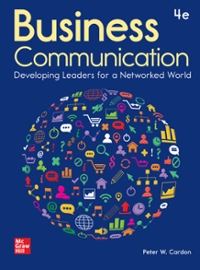Angela Nguyen, director of donor relations, sighed. She glanced at the statistics for the last quarter. Donations
Question:
Angela Nguyen, director of donor relations, sighed. She glanced at the statistics for the last quarter. Donations to the EdFirst were down 6 percent. Even worse, donations were down nearly 23 percent from two years ago. The foundation received about 5 percent of its revenue from program participants, about 35 percent from federal and state grants, and roughly 60 percent from individual donations. The foundation would need to drop critical services if donations didn’t pick up soon.
The EdFirst Foundation provided mentoring, after-school programs, and other resources for K–12 children from low-income families in inner cities. Any child in any of the ten cities EdFirst operated in qualified for the program. Children from families that fell below the federal poverty line received all services for free.
Children from families above the poverty line received the services at highly discounted rates of between $25 and $75 per year. Approximately 92 percent of children participating in EdFirst programs came from families that fell under the federal poverty line.
The foundation employed some full-time center directors and part-time staff members. However, most of the work was done by volunteers. For example, all mentors were volunteers. The average mentor had served for nearly 7 years and volunteered an average of 2.3 hours per week to help struggling students. Volunteers also helped with after-school programs held in EdFirst facilities, developed educational materials, and recruited children to join the programs.
Recently, Angela commissioned several third parties to evaluate the performance of the foundation. In the first evaluation, an independent evaluator identified the following impacts for children participating in EdFirst programs:
● Reading levels improved by 1.4 grade levels after 6 months of active participation.
● Reading levels improved by 2.3 grade levels after 12 months of active participation.
● Math scores improved by 1.9 grade levels after 6 months of active participation.
● Math scores improved by 2.6 grade levels after 12 months of active participation.
● High school graduation rates in areas served by EdFirst stood at 43 percent. In these same areas, the high school graduation rate for individuals who had participated for at least one year between the ages of 12 and 18 years old was 72 percent. The high school graduation rate for individuals who had participated for at least three years between the ages of 12 and 18 years old was 96 percent.
In the second evaluation, a separate independent accreditor found the following about the foundation:
● 92 percent of all donations were used directly for the educational programs. In other comparable non-profit organizations, an average of 78 percent of all donations were used directly for educational programs.
● 89 percent of EdFirst volunteers had undergraduate degrees, and 38 percent had graduate degrees.
● 97 percent of parents of EdFirst program participants were
“extremely satisfied” with EdFirst services.
While EdFirst aimed to keep expenses as low as possible, it incurred significant costs to rent and own various education centers, supply textbooks and other curricular materials, provide transportation to and from its centers for program participants and volunteers, and run various after-school activities.
Angela was extremely frustrated. With all the good news about the positive impacts on inner-city kids and operational efficiency, she realized the foundation would have to cut back services for some kids or even close some centers if donations didn’t pick up.
Based on her calculations, the average cost to support a child in the program for an entire year was just $236.
She decided that she would send a message to prior donors who had not donated in over a year. She would ask these prior donors to enroll in the “EdFirst Support a Kid” program. Enrolling in this program involved a $20 monthly donation.
Your Task: Assume you are in charge of sending a message to past donors. Write a message to past donors asking them to join the
“EdFirst Support a Kid” program.
Step by Step Answer:






